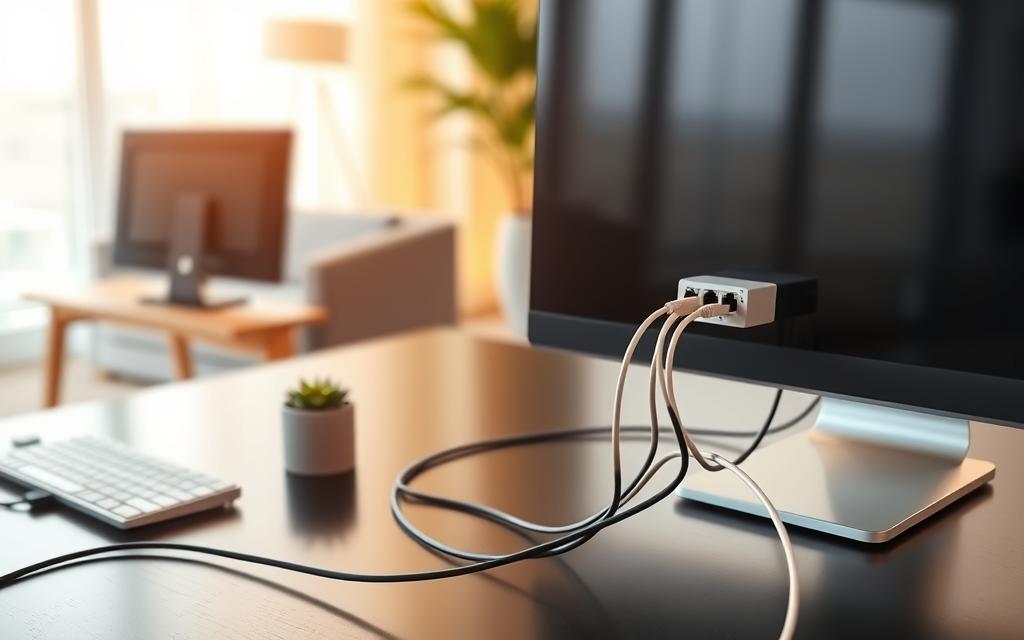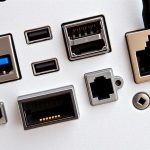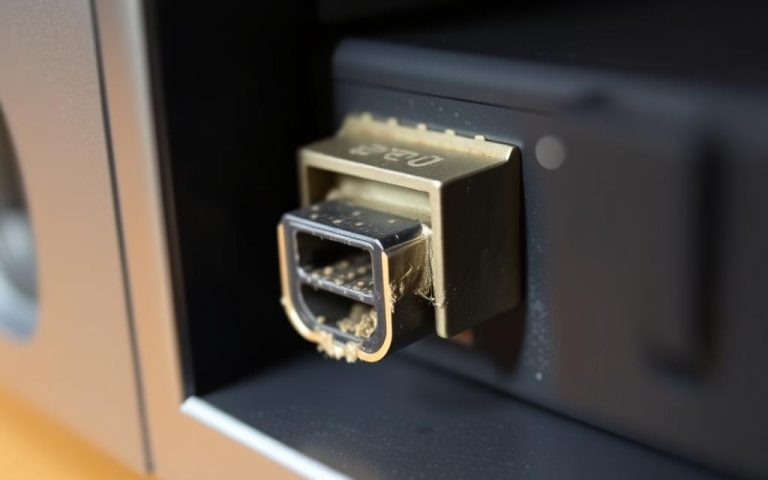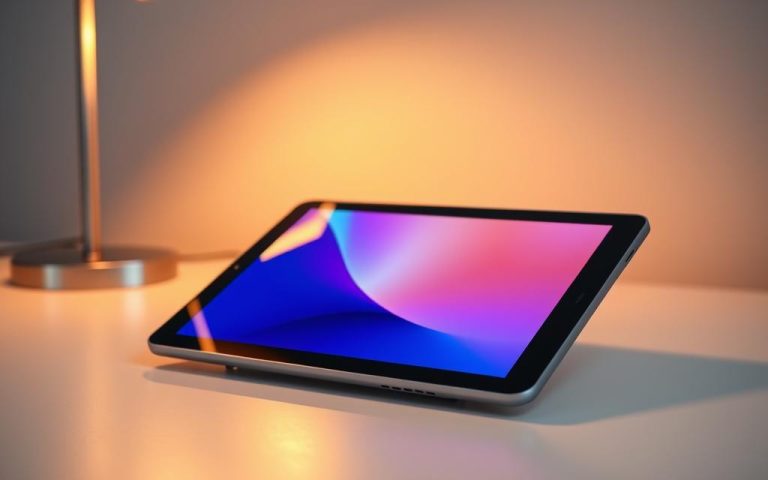Can Computers Be Connected to PoE Ports?
Is it possible to connect a computer to a PoE port? Power over Ethernet (PoE) is changing how we connect devices. It allows both data and power to travel through one cable. This is handy for many uses. Yet, whether standard computers can use PoE ports is still something people wonder about.
Different PoE switches work with many PoE devices. But, it’s vital to know the difference between active and passive PoE. Active PoE switches can tell if a device needs power. This avoids any danger of damage to non-PoE gadgets. In the past, passive PoE switches didn’t have this feature. So, picking the right network setup is important.
Understanding Power over Ethernet (PoE)
Power over Ethernet (PoE) is an innovative tech that combines power with data over one cable. It simplifies connecting devices such as IP cameras and phones. By doing so, it removes the need for extra power sources, making setups neater.
What is PoE?
What exactly is Power over Ethernet? It allows network cables to carry both data and power. PoE works well between 44 to 57 volts DC, usually using 48 volts. This makes setting up devices easier without the mess of power cables.
How Does PoE Work?
How PoE functions involves power sourcing equipment (PSE) and powered devices (PD). A PSE might be a switch that sends power to a PD like a camera. This process is safe and follows strict standards, ensuring reliable use anywhere.
Types of PoE Standards
We see different PoE standards over time, improving how much power is sent:
- IEEE 802.3af (Type 1 PoE): Provides up to 15.4 watts per port, with actual use near 13 watts.
- IEEE 802.3at (PoE+ or Type 2): Offers up to 25.5 watts, and started in 2009.
- IEEE 802.3bt (Type 3 and Type 4): Launched in 2018, Type 3 gives 51 watts, while Type 4 offers up to 71.3 watts.
The various PoE standards not only set the power limits but also define what devices can be supported. These standards have evolved, meeting the growing needs of network systems.
Can I Plug a Computer into a PoE Port?
Hooking a computer up to Power over Ethernet (PoE) tech brings up big questions about compatibility and safety. Finding out how to plug a computer into a PoE port can boost efficiency in many setups. Users often wonder if it’s both possible and safe to connect their computer, especially where plug sockets are scarce.
Compatibility with Non-PoE Devices
Linking non-PoE devices to PoE ports is easy and useful for many setups. You can connect computers and other non-PoE gadgets to PoE ports with no trouble. The PoE switch smartly checks if a device needs power. If not, it only sends data, ensuring the non-PoE device works just fine. This smooth connection lets you hook up several devices without hurting their performance.
Safe Operation of Computers on PoE Ports
It’s vital to ensure computers safely work with PoE tech. The choice of PoE standards is key here. Active PoE switches talk to devices to work out their power needs. This stops any damage from too much voltage or current. With passive PoE, you must be careful since it might not check power needs well, risking inconsistent power. Using a compliant PoE switch helps keep computers safe while getting the most out of PoE.
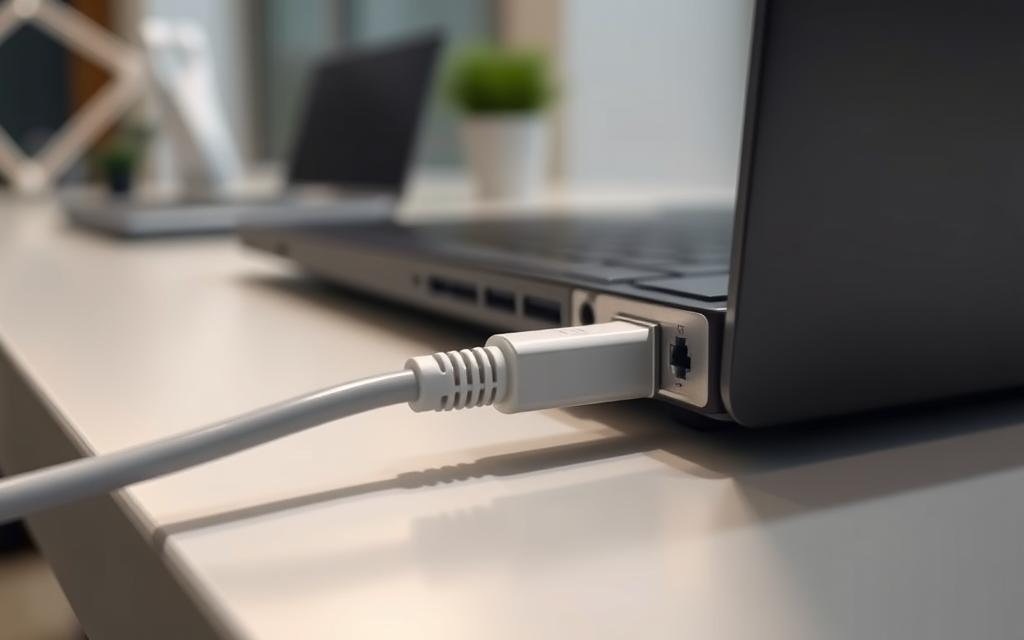
| Device Type | PoE Compatibility | Power Delivery Mechanism |
|---|---|---|
| Computers | Supported via PoE ports | Depends on switch compliance with 802.3af/at |
| Access Points | PoE-enabled | Standardised power negotiation |
| IP Cameras | Typically PoE compliant | Active negotiation with switches |
| VoIP Phones | Compatible with PoE | 802.3af standard compliant |
Potential Risks of Connecting Computers to PoE Ports
As the use of Power over Ethernet (PoE) grows, knowing the risks is key. This is especially important in offices. People often ask about the safety of connecting their computers to PoE switches or injectors. We’ll look at the safety of electrical currents and how passive and active PoE differ.
Electrical Current and Device Safety
Most PoE switches meet the IEEE 802.3af standard, which makes them fairly safe. Yet, we must always be careful. Using passive PoE injectors needs extra caution since they always send power. This could be risky for devices not made for it. Sticking to safety standards helps avoid these dangers.
Passive PoE vs. Active PoE
Knowing the difference between passive and active PoE is important. Passive PoE always sends power without checking if the device can handle it. It might not stop sending power if there’s too much, risking damage. Active PoE talks to devices to find out how much power they need. This makes things safer.
Before you connect computers to PoE ports, think about these points. Choose PoE switches from trusted companies like Ubiquiti or Netgear. Making sure they fit PoE standards will help prevent damage and keep your network safe.
Benefits of Using PoE for Data Transfer
Power over Ethernet (PoE) technology combines power and data through one cable. It makes installation simpler and cuts costs. Knowing its benefits helps businesses pick the best cabling solutions.
Streamlined Cabling Solutions
PoE means no separate power cables are needed. This makes installation quicker and reduces mess. It leads to faster setup and tidier workspaces.
Enhanced Flexibility and Scalability
PoE is great for adding devices without extra electrical outlets. It’s perfect for IoT devices that may be placed in various locations. PoE extenders also allow for data transfer up to 4000 feet, fitting different business sizes.
Using PoE changes how networks are managed. It ensures efficient data transfer and supports adaptable infrastructure. FSP’s PoE Switches show how to use these advantages well.
| Type of PoE Switch | Suitable For | Main Features |
|---|---|---|
| Unmanaged | Small businesses (5-10 computers) | Plug-and-play functionality |
| Smart/Hybrid | VoIP and smaller networks | Port configuration, virtual network support |
| Managed | Data centres and enterprise networks | Advanced control and security features |
Conclusion
In summary, using Power over Ethernet (PoE) ports with computers offers an exciting way to handle networking and power. It’s important for users to know that while many PoE setups work with computers, safe use depends on the type of PoE. Active PoE systems, like 802.3at and 802.3bt, are made to safely give power. They provide enough energy for devices such as laptops, which need 50 watts or more.
Passive PoE systems, however, can be risky for devices not made for PoE. These systems might not correctly manage power, leading to too much voltage or current. This could harm the computers. So, it’s crucial to think carefully when adding PoE to your network. Using managed or auto-sensing PoE switches helps. This is especially true in setups with both PoE and non-PoE devices.
Understanding the ins and outs of PoE standards lets users make the most of Power over Ethernet. It ensures their devices are safe. This smart use of technology improves how networks operate. It lets people take full advantage of PoE benefits without risking their equipment’s safety.
FAQ
Can I plug a computer into a PoE port?
Indeed, plugging a computer into a PoE port is possible. The PoE switch checks if the device needs power and supplies it accordingly. Devices that don’t need power will still get data.
What happens if I connect a non-PoE device to a PoE port?
Connecting a non-PoE device to a PoE port will still let the device work fine. It will use the network cable for data. The PoE switch makes sure only the right devices get power.
Is it safe to connect my computer to a PoE switch?
Yes, connecting your computer to a PoE switch is mostly safe. If the PoE switch follows set standards, risks are low. But, be careful with passive PoE injectors, as they might send too much power.
What is the difference between passive PoE and active PoE?
Active PoE checks if a device can get power and only gives power if needed. This keeps non-PoE devices safe. On the other hand, passive PoE can be dangerous as it always sends power.
What are the benefits of using PoE for data transfer?
PoE makes setting up network devices easier by using one cable for both power and data. This means less mess and more flexibility in designing your network.
Are there any risks associated with using PoE technology?
PoE is mostly safe, but there can be dangers, especially with passive PoE systems. These might send too much power to non-PoE devices. It’s important to know which PoE your device uses.
Can PoE technology improve network scalability?
Absolutely, PoE can help make networks more flexible and scalable. It lets you add devices in difficult places without worrying about power supplies. This makes growing your network easier.

